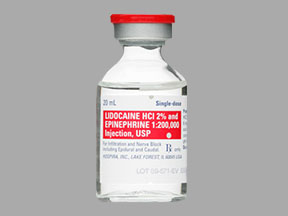
Lidocaine-epinephrine Coupons & Savings Card – Discount Prices from $1.01
Generic for: Xylocaine/epinephrine
My prescription
Edit
10ML of 2%-1:200000, Lidocaine-epinephrine (1 Vial)
Select pharmacy

CVS
$25.95
COUPON PRICE
Walmart
$1.01
COUPON PRICE
Walgreens
$2.00
COUPON PRICE
Albertsons
$8.44
COUPON PRICELidocaine-epinephrine savings card
Show this card to your pharmacist
Walmart
$1.01
BIN
ID
PCN
GRP
019876
LH471976BC
CHIPPO
LHX
Powered by
Lidocaine-epinephrine dosage forms
Dosage Quantity Price from Per unit 10ML of 2%-1:200000 1 Vial $1.01 $1.01 10ML 1 Vial $1.01 $1.01 10ML 2 Vials $1.01 $0.51 10ML 3 Vials $1.01 $0.34 10ML of 2%-1:200000 2 Vials $1.01 $0.51 10ML of 2%-1:200000 3 Vials $6.18 $2.06 50ML of 0.5%-1:200000 1 Vial $1.01 $1.01 50ML of 0.5%-1:200000 2 Vials $2.42 $1.21 50ML of 0.5%-1:200000 3 Vials $6.12 $2.04
| Dosage | Quantity | Price from | Per unit |
|---|---|---|---|
| 10ML of 2%-1:200000 | 1 Vial | $1.01 | $1.01 |
| 10ML | 1 Vial | $1.01 | $1.01 |
| 10ML | 2 Vials | $1.01 | $0.51 |
| 10ML | 3 Vials | $1.01 | $0.34 |
| 10ML of 2%-1:200000 | 2 Vials | $1.01 | $0.51 |
| 10ML of 2%-1:200000 | 3 Vials | $6.18 | $2.06 |
| 50ML of 0.5%-1:200000 | 1 Vial | $1.01 | $1.01 |
| 50ML of 0.5%-1:200000 | 2 Vials | $2.42 | $1.21 |
| 50ML of 0.5%-1:200000 | 3 Vials | $6.12 | $2.04 |
Lidocaine-epinephrine Warnings
When using lidocaine combined with epinephrine, it's important to be aware of several potential risks:
Methemoglobinemia: This condition involves an abnormal amount of methemoglobin in the blood, reducing its ability to carry oxygen. Certain individuals, including those with specific genetic conditions, infants under six months, and people with heart or lung issues, are more susceptible. Symptoms can appear immediately or several hours after exposure and may include skin discoloration and unusual blood color. Immediate treatment is necessary to prevent severe complications.
Chondrolysis with Intra-Articular Infusion: Injecting local anesthetics like lidocaine with epinephrine directly into joints, especially the shoulder, has been linked to cartilage damage (chondrolysis). Symptoms such as joint pain, stiffness, and reduced motion can develop as early as two months post-surgery. Currently, there is no effective treatment for this condition.
Allergic Reactions to Sulfites: Lidocaine with epinephrine contains sodium metabisulfite, which can trigger allergic reactions, including severe asthma episodes, in sensitive individuals. People with asthma are more likely to experience these reactions.
Systemic Toxicities from Unintended Injections: Accidental injection of the anesthetic into blood vessels or the spinal canal can lead to serious systemic effects, such as central nervous system or cardiovascular depression, and in severe cases, coma or respiratory arrest. To minimize this risk, healthcare providers should aspirate for blood or cerebrospinal fluid before administering the drug.
Use in Areas with Limited Blood Supply: Injecting lidocaine with epinephrine into body parts with restricted blood flow, like fingers, toes, or the nose, can cause tissue damage due to reduced circulation. This risk is higher in individuals with peripheral vascular disease or high blood pressure.
Risk of Cardiac Arrhythmias with Certain Anesthetics: Using lidocaine with epinephrine alongside potent inhalation anesthetics can increase the likelihood of serious heart rhythm disturbances. The combined effects on the heart should be carefully considered in such cases.
Use in the Head and Neck Area: Even small doses injected into the head and neck can lead to adverse reactions similar to those seen with larger doses injected elsewhere. These may include confusion, convulsions, or respiratory issues. Such procedures require utmost care and immediate availability of resuscitative equipment.
Familial Malignant Hyperthermia: While it's unclear if amide-type local anesthetics like lidocaine trigger this rare but serious reaction, it's advisable to have a management protocol in place. Early signs include rapid heart rate, rapid breathing, unstable blood pressure, and metabolic acidosis. Prompt recognition and treatment are crucial for a successful outcome.
Respiratory Arrest in Ophthalmic Surgery: There have been reports of respiratory arrest following local anesthetic injections during eye surgeries. It's essential to have resuscitative equipment and trained personnel ready to manage such emergencies.
Inadvertent Trauma in Dental Applications: Due to prolonged numbness, patients may unintentionally injure their tongue, lips, or cheeks after dental procedures. It's important to avoid chewing solid foods until sensation returns to prevent such injuries.
Being aware of these risks and taking appropriate precautions can help ensure the safe use of lidocaine with epinephrine in various medical procedures.
Lidocaine-epinephrine Side Effects
Lidocaine combined with epinephrine is commonly used to numb specific areas during medical procedures. While generally safe, it's important to be aware of potential side effects that can occur. Common Side Effects:
- Nervous System Reactions: Some individuals may experience lightheadedness, nervousness, apprehension, euphoria, confusion, dizziness, drowsiness, tinnitus (ringing in the ears), blurred or double vision, vomiting, sensations of heat, cold, or numbness, twitching, tremors, convulsions, unconsciousness, respiratory depression, and arrest.
- Cardiovascular Effects: Possible effects include bradycardia (slow heart rate), hypotension (low blood pressure), and cardiovascular collapse.
- Allergic Reactions: Symptoms may include skin lesions, hives (urticaria), swelling (edema), or more severe allergic responses.
- Neurologic Issues: Some patients might experience positional headaches, hypotension, and backache.
- Blood Disorders: A rare condition called methemoglobinemia, which affects the blood's ability to carry oxygen, has been reported.
Serious Side Effects: In rare cases, more severe reactions can occur, such as:
- Central Nervous System Toxicity: Symptoms may include restlessness, anxiety, incoherent speech, lightheadedness, numbness and tingling of the mouth and lips, metallic taste, tinnitus, dizziness, blurred vision, tremors, twitching, convulsions, unconsciousness, respiratory depression, and arrest.
- Cardiovascular Collapse: High doses or accidental injection into a blood vessel can lead to serious heart issues, including decreased cardiac output, heart block, hypotension, bradycardia, ventricular arrhythmias, and cardiac arrest.
- Methemoglobinemia: This condition reduces the blood's ability to carry oxygen and may present with symptoms like cyanotic skin discoloration and abnormal coloration of the blood.
Precautions:
- Allergies: Inform your healthcare provider if you have known allergies to lidocaine, epinephrine, or sulfites, as some formulations contain sodium metabisulfite, which can cause allergic reactions in susceptible individuals.
- Medical Conditions: Patients with liver disease, heart conditions, or certain blood disorders should use this medication cautiously and under close medical supervision.
- Drug Interactions: Be sure to discuss all medications you're currently taking with your healthcare provider, as certain drugs can interact with lidocaine and epinephrine, leading to increased risks of side effects.Always consult with your healthcare provider to ensure that lidocaine with epinephrine is appropriate for your specific medical situation and to understand the potential risks and benefits.
Lidocaine-epinephrine Interactions
Lidocaine combined with epinephrine is commonly used in medical procedures to provide local anesthesia and reduce bleeding. However, this combination can interact with various medications, potentially leading to serious health issues. It's important to be aware of these interactions to ensure safe treatment.
Interactions with Other Medications:
Monoamine Oxidase Inhibitors (MAOIs) and Tricyclic Antidepressants: Using lidocaine with epinephrine alongside these antidepressants can cause severe and prolonged high blood pressure. It's generally advised to avoid this combination. If it's necessary, close monitoring of blood pressure is essential.
Ergot-Type Oxytocic Drugs: Combining these drugs with lidocaine and epinephrine may lead to dangerously high blood pressure or even strokes. Therefore, their concurrent use should be avoided.
Nonselective Beta-Blockers: These medications can interact with lidocaine and epinephrine, resulting in severe high blood pressure and slow heart rate. If both are used together, careful monitoring of heart rate and blood pressure is crucial.
Other Local Anesthetics: Using multiple local anesthetics together can increase the risk of toxic effects. If combining them is unavoidable, patients should be closely observed for signs of nervous system or heart-related side effects.
Drugs Associated with Methemoglobinemia: Certain medications, when used with local anesthetics like lidocaine, can raise the risk of methemoglobinemia—a condition where the blood can't carry oxygen effectively. These include nitrates, some antibiotics, and specific antimalarial drugs. Patients should be monitored for symptoms like skin discoloration, fatigue, or shortness of breath.
Potent Inhalation Anesthetics: Using lidocaine with epinephrine during or after administration of strong inhaled anesthetics can lead to serious heart rhythm problems. This combination should be approached with caution.
Phenothiazines and Butyrophenones: These drugs may reduce or reverse the blood pressure-raising effects of epinephrine. If used together, careful monitoring is necessary.
Food and Lifestyle Interactions:
Grapefruit Juice: Consuming grapefruit juice can increase lidocaine levels in the blood, heightening the risk of side effects like low blood pressure and irregular heart rhythms. It's advisable to avoid grapefruit juice during treatment.
Caffeine: Both epinephrine and caffeine can raise blood pressure and heart rate. Combining them may amplify these effects, so it's important to monitor for any adverse reactions.
Smoking and Certain Vegetables: Smoking and eating cruciferous vegetables like broccoli can decrease lidocaine levels, potentially reducing its effectiveness. Discuss any dietary habits or smoking with your healthcare provider.
Disease Interactions:
Individuals with certain health conditions should exercise caution when using lidocaine with epinephrine:
Heart Disease or High Blood Pressure: The combination can exacerbate these conditions.
Liver Disease: Lidocaine is processed by the liver, so impaired liver function can lead to increased drug levels and potential toxicity.
Methemoglobinemia: Those with a history of this condition should avoid medications that can induce it.
Always inform your healthcare provider about all medications, supplements, and health conditions before receiving lidocaine with epinephrine. This ensures the safest and most effective treatment plan tailored to your needs.
